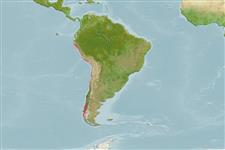Bivalvia |
Cardiida |
Psammobiidae
Environment: milieu / climate zone / Mức độ sâu / distribution range
Sinh thái học
; Mức độ sâu 0 - 20 m (Tài liệu tham khảo 75339). Subtropical; 3°S - 49°S, 82°W - 67°W
Southeast Pacific: Peru to Chile.
Length at first maturity / Bộ gần gũi / Weight / Age
Chín muồi sinh dục: Lm ? range ? - ? cm
Intertidal to subtidal to a depth of 20 m. Infaunal burrower in sandy substrates (Ref. 75339). Feeds on plankton and organic detritus (Ref. 107091).
Life cycle and mating behavior
Chín muồi sinh dục | Sự tái sinh sản | Đẻ trứng | Eggs | Sự sinh sản | Larvae
Members of the class Bivalvia are mostly gonochoric, some are protandric hermaphrodites. Life cycle: Embryos develop into free-swimming trocophore larvae, succeeded by the bivalve veliger, resembling a miniature clam.
MarineSpecies.org 2050 MarineSpecies.org. http://www.marinespecies.org/index.php (Tài liệu tham khảo 3477)
IUCN Red List Status
(Tài liệu tham khảo 130435: Version 2025-1)
CITES status (Tài liệu tham khảo 108899)
Not Evaluated
CMS (Tài liệu tham khảo 116361)
Not Evaluated
Threat to humans
Harmless
Human uses
Các nghề cá: Tính thương mại
| FishSource |
Các công cụ
Thêm thông tin
Life cycleSự tái sinh sảnChín muồi sinh dụcSự sinh sảnĐẻ trứngEggsEgg developmentLarvae PhysiologyThành phần ô-xy
Human RelatedStamps, coins, misc.
Các nguồn internet
Estimates based on models
Preferred temperature
(Ref.
115969): 12.4 - 20.6, mean 18.1 (based on 136 cells).
Thích nghi nhanh
Chiêù cao, thời gian nhân đôi của chủng quần tối thiểu là dưới 15 tháng (K=0.31).
